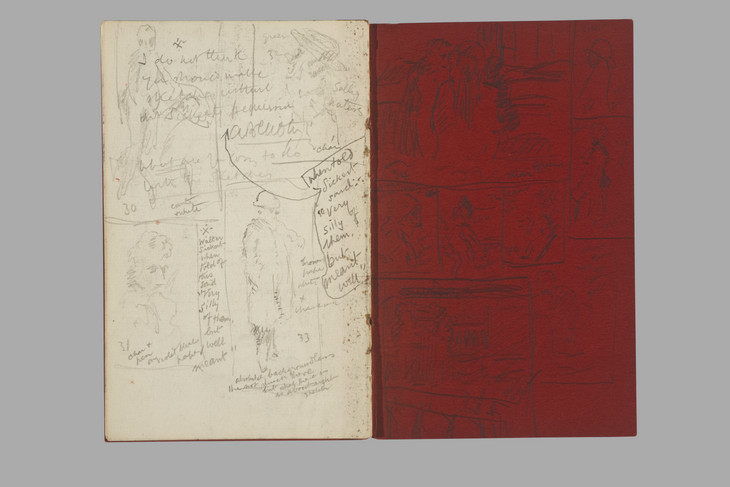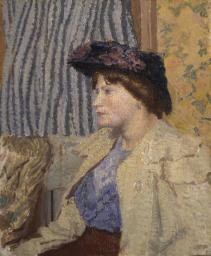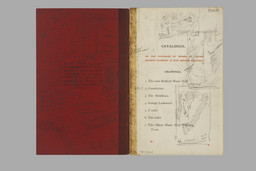Follower of Walter Richard Sickert The Straw Hat c.1911
Follower of Walter Richard Sickert,
The Straw Hat
c.1911
This archetypal Camden Town Group subject, a woman wearing a flat straw hat popular among London flower-sellers, or costermongers, is the work of an unidentified artist. Made in the interior of Walter Sickert’s studio, Wellington House Academy on the corner of Granby Street and 247 Hampstead Road, the left-facing profile, careful detail of elaborately coiled hair and resemblance of the sitter to female models in Sickert’s own paintings reveals his strong influence on the picture’s style, subject matter and composition.
Follower of Walter Richard Sickert 1860–1942
The Straw Hat
c.1911
Graphite on paper
279 x 190 mm
Presented by the Contemporary Art Society 1941
N05309
c.1911
Graphite on paper
279 x 190 mm
Presented by the Contemporary Art Society 1941
N05309
Ownership history
Walter Sickert; Redfern Gallery, London, purchased by Contemporary Art Society 1941 and presented to Tate Gallery.
Exhibition history
1942
The Tate Gallery’s Wartime Acquisitions, National Gallery, London, April–May 1942 (36, as by Harold Gilman).
1942–3
A Selection from the Tate Gallery’s Wartime Acquisitions, (Council for the Encouragement of Music and the Arts tour), Royal Exchange, London, July–August 1942, Cheltenham Art Gallery, September 1942, Ashmolean Museum, Oxford, October 1942, Galleries of Birmingham Society of Arts, November–December 1942, Fitzwilliam Museum, Cambridge, January–February 1943, Victoria Art Gallery, Bath, February–March 1943, National Museum of Wales, Cardiff, March–April 1943, Manchester City Art Gallery, April–May 1943, Philharmonic Hall, Liverpool, May–June 1943, National Gallery of Scotland, Edinburgh, June 1943, Glasgow Museum and Art Gallery, Kelvingrove, July 1943, Laing Art Gallery, Newcastle upon Tyne, August 1943 (17, as by Harold Gilman).
References
1942
Contemporary Art Society Report 1940–41, London 1942, p.12, as by Harold Gilman.
1948
John Russell, From Sickert to 1948, London 1948, reproduced pl.17, as by Harold Gilman.
1964
Mary Chamot, Dennis Farr and Martin Butlin, Tate Gallery Catalogues: The Modern British Paintings, Drawings and Sculpture, vol.2, London 1964, p.641.
Technique and condition
The Straw Hat is a graphite and copy pencil drawing on wove paper. The paper is machine made, medium weight and off-white in tone. The top and bottom edges of the sheet are cut straight and the right and left are uneven, suggesting they have been torn. The drawing was created using a soft graphite pencil and covers the majority of the paper sheet. In the shadow areas of the sitter’s hat and hair, details have been emphasised with a copy pencil,1 which produces a black matt line.
Kate Jennings
November 2005
Notes
An indelible pencil that cannot be easily erased by rubbing out or washing off, the pencil is essentially graphite but also contains a dye, producing a softer line with a bluish tinge, sometimes described as ‘copying ink pencils’. See Sheila Fairbrass, ‘The Problem of Copy Pencil in Works of Art on Paper’, Conservator, vol.8, 1984, p.8.
How to cite
Kate Jennings, 'Technique and Condition', November 2005, in Nicola Moorby, ‘The Straw Hat c.1911 by Follower of Walter Richard Sickert’, catalogue entry, February 2009, in Helena Bonett, Ysanne Holt, Jennifer Mundy (eds.), The Camden Town Group in Context, Tate Research Publication, May 2012, https://wwwEntry

Walter Richard Sickert 1860–1942
Lou! Lou! I Love You 1911
Lithograph on paper
332 x 220 mm
Inscribed by the artist 'Sickert. 1911.' bottom right
Tate Archive TGA 8120/3/49
© Estate of Walter R. Sickert / DACS
Fig.1
Walter Richard Sickert
Lou! Lou! I Love You 1911
Tate Archive TGA 8120/3/49
© Estate of Walter R. Sickert / DACS
In 1941 the Director of the Tate Gallery, John Rothenstein, asked his uncle and former Fitzroy Street Group member, Albert Rutherston (1881–1953), to give his opinion as to its authorship. In a letter to his nephew, Rutherston wrote:
I have examined very carefully the 2 drawings attributed to Innes & Gilman. [Randolph] Schwabe came along with me. He agrees entirely with my view of the Gilman – it is a Sickert – not a Gilman. The girl was my model for the Laundry and Coster Girls pictures & she only sat to Sickert (occasionally) apart from myself. This is corroborative evidence but apart from this Gilman could not have made this drawing. He had not this power with pencil & pen & the touch is Sickert’s – a careful Sickert.3
Despite Rutherston’s certainty, and despite the obvious similarity to other compositions, the careful tonal style of The Straw Hat is quite unlike Sickert’s style of draughtsmanship and since 1964 the work has been ascribed to a follower.4 This attribution has also been endorsed by the art historian Wendy Baron who believes the artist was
definitely someone who used Sickert’s studios and his models between 1908 and 1911. On grounds of style, I think Malcolm Drummond is more likely than Gilman but in truth there are simply too many possibilities to narrow it down without some kind of supporting, documentary evidence.5
She has identified the fireplace in the background of the drawing as the same as that which appears in a number of Sickert’s works dating from his Camden Town period, including The New Home 1908 (fig.2) and Ennui c.1914 (Tate N03846). As Baron has confirmed, this identifies the setting of the drawing as the ‘Wellington House Academy’ studio on the corner of Granby Street and 247 Hampstead Road, which Sickert rented between at least 1908 and 1914.6 Although he never officially ran an art school from there, it seems likely that he shared both the space, and his models, with some of his many students during this period. The catalogue of an exhibition held at the Carfax Gallery in 1913 by ‘Past and Present Pupils of Mr Sickert’, for example, contains a couple of drawings and etchings by Regina Middleton entitled Dickens’ First School.7 This may be a reference to the ‘Wellington House Academy’, so called because it had once housed a school by that name attended by Charles Dickens.8

Walter Richard Sickert 1860–1942
The New Home 1908
Oil paint on canvas
495 x 390 mm
Private collection, Ivor Braka Ltd
© Estate of Walter R. Sickert / DACS
Photo © Ivor Braka Ltd, London
Fig.2
Walter Richard Sickert
The New Home 1908
Private collection, Ivor Braka Ltd
© Estate of Walter R. Sickert / DACS
Photo © Ivor Braka Ltd, London

Albert Rutherston 1881–1953
Laundry Girls 1906
Oil paint on canvas
support: 915 x 1170 mm
Tate N04996
Presented by Humbert Wolfe 1939
© Tate
Fig.3
Albert Rutherston
Laundry Girls 1906
Tate N04996
© Tate
There are at least two possible suggestions regarding the identity of the female model in The Straw Hat. As Rutherston proposed in the letter quoted above, the model may be the same figure as the fair-haired girl marking sheets in his painting, The Laundry Girls 1906 (Tate N04996, fig.3). In an article for the Burlington Magazine in 1943 Rutherston wrote:
I was fortunate at that moment in having several Coster girls as models for a series of paintings I was at work upon – The Laundry Girls (Tate Gallery) was one, and Emily, the younger of the two who sat for this, blonde, amusing and pert, found great favour in the eyes of Sickert, who delighted to draw and paint her. 9
A drawing by Rutherston of Emily in profile was reproduced in the same article and comparison with The Straw Hat reveals similar features, including a small upturned nose.10

Drawings by Walter Sickert January 1911
V SICKER
Fig.4
Drawings by Walter Sickert January 1911
V SICKER
Regardless of whether the girl in The Straw Hat is Emily or Sally Waters, the actual identity of the sitter is of secondary importance to her perceived social classification. Like many of the women who feature in Camden Town images she is representative of a particular urban stereotype. Her flat straw hat, combined with the fact that she is wearing an outdoor coat in an interior setting, lead the viewer to the inevitable assumption that this woman is a working class urban type, the Camden Town coster-girl.15
Nicola Moorby
February 2009
Notes
Mary Chamot, Dennis Farr and Martin Butlin, Tate Gallery Catalogues: The Modern British Paintings, Drawings and Sculpture, vol.2, London 1964, p.641.
Paintings, Drawings and Etchings by Past and Present Pupils of Mr. Sickert, exhibition catalogue, Carfax Gallery, London 1913, nos.60–2. Regina Middleton was the niece of Diana White, a friend of Lucien and Esther Pissarro.
Albert Rutherston, ‘From Orpen and Gore to the Camden Town Group’, Burlington Magazine, vol.83, no.485, August 1943, p.202.
Baron 2006, no.350.6. Reproduced in British and Irish Traditionalist and Modernist Paintings, Drawings and Sculpture, Christie’s, London, 3 March 1989 (lot 309).
Related biographies
Related catalogue entries
Related archive items
-
Drawings by Walter Sickert January 1911Exhibition catalogue
Related reviews and articles
- Albert Rutherston, ‘From Orpen and Gore to the Camden Town Group’ The Burlington Magazine, vol.83, no.485, August 1943, pp.201–5.
How to cite
Nicola Moorby, ‘The Straw Hat c.1911 by Follower of Walter Richard Sickert’, catalogue entry, February 2009, in Helena Bonett, Ysanne Holt, Jennifer Mundy (eds.), The Camden Town Group in Context, Tate Research Publication, May 2012, https://www





